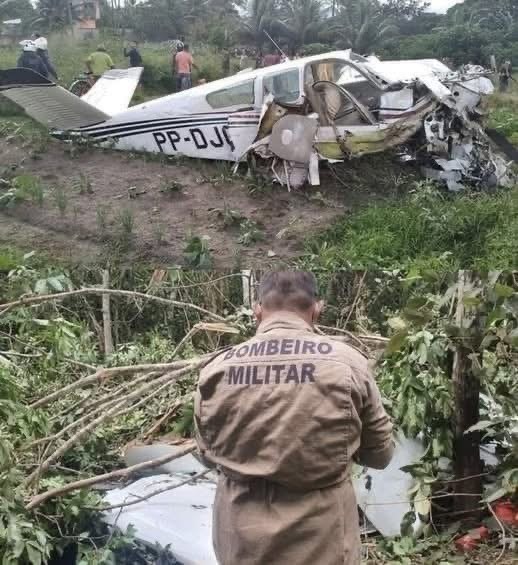RIGHT NOW, PLANE WITH MORE THAN 23 ONBOARD JUST CRASH! See more
The first reports came in fast, and none of them were good. A plane carrying more than twenty-three passengers had gone down just moments earlier, crashing hard enough that people miles away felt the impact. Within minutes, social media was swamped with shaky videos showing a column of black smoke twisting into the sky. What looked like scattered debris was already burning on the ground. People nearby described the sound as a single, violent blast — the kind of noise that cuts through everything and leaves a ringing silence afterward.
Authorities confirmed only the basics at first: the aircraft lost contact with air traffic control shortly before the crash. No explanation. No warning. Just sudden radio silence. Tower officials tried repeatedly to reach the pilot, but there was nothing but static. Now, investigators are trying to piece together those missing minutes that turned a routine flight into a catastrophe.
Rescue teams moved fast. Firefighters, paramedics, and emergency responders tore through the blocked-off area, battling smoke thick enough to sting the eyes from a distance. Helicopters hovered above the wreckage, their lights cutting through the haze as workers searched for any sign of movement — any chance that someone might still be alive. The crash site was too dangerous for civilians, so authorities shut the entire area down. Roads in every direction were sealed off to keep people back and give rescuers the space they needed.
From the early images, it was obvious the plane hit the ground hard. The fuselage was barely recognizable. Wings snapped clean. Seats and fragments scattered across a wide radius. The kind of destruction that tells its own story — one with very few survivors, if any.
At nearby airports, families of the passengers were gathering, desperate for answers. Some held their phones in shaking hands, refreshing news pages over and over. Others sat frozen in chairs, staring straight ahead because the alternative was collapsing. Airport staff did their best to keep them updated, but the truth was simple: no one knew anything concrete yet. And that uncertainty is its own kind of torment.
One witness, who lives close to the crash site, said the plane sounded like it was struggling before impact. He described the noise as inconsistent, almost like the engine was cutting out. Another resident said she saw the aircraft descending far too quickly, almost nose-first. Whether the pilot attempted an emergency landing or simply lost control remains unknown.
Investigators will have to wait until the scene is fully secured before digging into the wreckage. Their first priorities are the black boxes — the flight data recorder and the cockpit voice recorder. If the crash spared either of those, they may hold the answers that everyone is searching for. Until then, all anyone can do is speculate.
Officials are preparing to release a formal statement soon. Most likely, it will confirm casualties, outline the basic timeline, and promise a full investigation. What it won’t provide — at least not yet — is closure. That takes time. And for the families right now, every minute feels like an eternity.
This kind of tragedy hits hard because it’s so sudden. A normal day becomes a nightmare without warning. People board a plane thinking about work, vacations, reunions — never imagining that their final moments will be spent in the sky with no way out. It’s brutal, and it’s unfair, and it leaves behind a grief that doesn’t fade quickly.
Search and rescue operations are expected to continue through the night. Crews will work in shifts, combing through every piece of the wreckage to find survivors or recover remains. It’s slow, painful work, especially with the structural instability and the fires that keep reigniting.
In the coming days, experts will analyze every angle: weather conditions, mechanical failures, pilot performance, maintenance records, radar data, witness videos, and air traffic communication logs. Crashes rarely have one single cause. Usually, it’s a chain of small failures that line up in exactly the wrong way. But right now, none of that matters as much as the fact that human lives were lost — lives that can’t be replaced by investigations or reports.
Meanwhile, hospitals in the region are on alert, preparing to handle survivors if any are found. Emergency rooms have cleared beds. Trauma teams stand ready. It’s a bitter wait, hoping for a miracle but preparing for bad news. And families at the airport cling to that same fragile hope — hope that someone, anyone, might still come out alive.
The world is watching closely, because plane crashes aren’t just local tragedies. They shake people everywhere. Anyone who’s ever stepped onto an aircraft knows the quiet trust involved — trust in the pilot, in the machine, in the process. When something like this happens, that trust cracks. It reminds everyone how thin the line is between routine and disaster.
Right now, investigators insist on patience. They need time, and they need space. But patience is hard when your loved one was on that flight. Hard when your phone won’t ring. Hard when every siren you hear reminds you of the news you don’t want to receive.
As night falls over the wreckage, crews keep working under floodlights that cut through the smoke. The smell of burning metal hangs in the air. The scene is chaotic, but the mission is clear: find survivors, secure the site, and preserve every clue. The next hours will determine what the world learns tomorrow.
For now, the crash stands as a grim reminder of how fast life can change. One moment, ordinary. The next, irreversible.
And until officials release their full findings, all anyone can do is wait — hoping that somehow, against all odds, someone in that wreckage is still alive.





